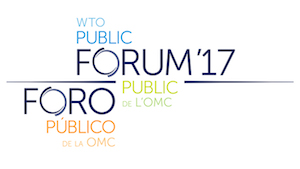Bridging the digital divide through the Information Technology Agreement (ITA)
28 Sep 2017 17:00h - 18:30h
Event report
[Read more session reports from WTO Public Forum 2017]
Moderator Mr John Neuffer, President & CEO, Semiconductor Industry Association,, started by introducing the panellists before pointing out how the Information Technology Agreement (ITA) helps to close the digital divide. The ITA does this firstly by taking away taxes and tariffs on information and communications technology (ICT), which in turn helps the development of small and medium-sized enterprises. According to Neuffer, the ITA not only aids achievement of the sustainable development goals (SDGs), it also signals to other countries and high-tech companies that the country implementing the ITA is ready for investments.
Mr Stephen Ezell, Vice President, Global Innovation Policy, Information Technology and Innovation Foundation, discussed key issues surrounding the ITA and ICT while pointing out how ICT has especially contributed to growth in the less developed countries (LDCs). Despite government investments, usually in ICT production and manufacturing, the best way to increase productivity in LDCs is via ICT consumption, which the ITA helps to facilitate, and in return this boostsoverall production. Participation in the ITA also integrates both the country and its companies effectively into global value chains, and boosts participation in ICT-related economic sectors and manufacturing. He also pointed out how the economic losses from tariffs are later covered by growth and access to ICT. Ezell concluded by stating that the ITA is perhaps the WTO’s most successful free trade agreement and creates a win-win situation for governments, businesses, and for citizens.
Ms Débora Ponce, Counselor, Permanent Mission of Guatemala to the WTO, stated how the Guatemalan economy is diversifying into ICT services, while ICT is spreading into other sectors. She emphasised the role of the ITA in providing cheaper access to the ICT-related technology required in manufacturing. She believes the ITA is also helping to construct infrastructure in urban and rural areas, while providing tools for private and public sectors, in addition to empowering individuals via education. For Ponce the Guatemalan example demonstrates that tariff losses associated with the ITA are recovered by subsequent economic growth while providing tools for the whole population to access ICT.
Mr Thaddeus Burns, Senior Legal Counsel, IP, Trade & Investment, General Electric, discussed how the ITA has been helpful in the provision of healthcare technology. According to him, the ITA has helped to drive the costs associated with healthcare down. Lower costs have been due to the simpler and smaller products which have provided more help with diagnostics than high-tech healthcare-related technology. The ITA has also improved innovation by providing further access to the necessary products and manufacturing in LDCs due to the lower tariffs, which encourages further investment. He finished by urging countries to sign and implement the ITA as it saves lives and he wishes that the healthcare sector be further integrated into the next round of the ITA.
Ms K.C. Swanson, Director of Global Policy, Telecommunications Industry Association, pointed out how the ITA has enabled global growth in mobile phone production and ownership, which together with ITA membership is key in staying economically competitive. In the field of export-related economic sectors this is because the ITA creates stability and certainty for investments while integrating country and business into global value chains, and at the same time bringing down the costs of accessing technology, and removing tariffs. Mobile phone technology facilitates access to global cross-border e-commerce in the LDCs through education and by narrowing the digital divide. Swanson concluded by stating how the ITA has facilitated all this by lowering tariffs.
Mr Toyooki Mitsui, Chief Specialist, Business Planning Division, Toshiba Memory Corporation), discussed how semi-conductors play a central role in ICT and the ITA as they provide products to other manufacturing sectors covered under the ITA. He pointed out that, as semi-conductors are essential in multiple sectors of manufacturing, from smartphones to e-commerce, which are covered by the ITA, it is paramount to ensure that future fields where the use of semi-conductors is emerging will also be covered by the ITA. Removing tariffs on semi-conductors via the ITA can also make ICT products more affordable.
Neuffer asked the panellists about the role of complementary policies which help countries and companies take full advantage of the ITA. According to Ezell, these are good governance and policies which facilitate clear data flows, possession of good infrastructure, and technological education policies. He also highlighted the role of attraction rather than compulsion in gaining ICT investments and in this the ITA is essential.
Panellists were also asked about the issue of revenue loss from losing tariffs, but Ponce suggested that longer implementation periods or ‘staging periods’ and the flexibility they provide helped to gain the support of reluctant governments. Swanson also pointed out that governments might make gains in economic terms which they did not anticipate initially.
Moderator Neuffer finished by thanking the panellists and participants.
by Arto Väisänen
Related topics
Related event

